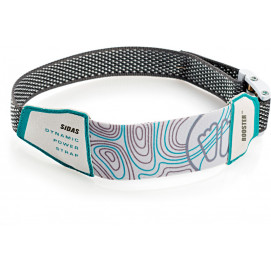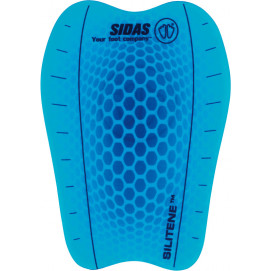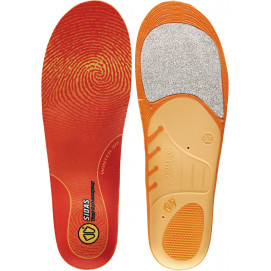 Maurice Manificat, best french cross-country skier Read more
Maurice Manificat, best french cross-country skier Read more In the shoes of Juliette Willmann, french women's freerider

For her second year on the Freeride World Tour, Juliette Willmann, the rising star of French freeriding, is aiming for the top. Her first winter was a steep learning curve, finishing in 7th place, an “encouraging but far from satisfactory” position, the 23-year-old athlete is nothing but ambitious. She has the ambition that is a constant in the mind of champions. Ambition coupled with an unusual strength of character that translates into powerful, elegant and flawless technique. A technical virtuosity honed on in her native Southern Alps and acquired from ten years of alpine skiing. She gave up downhill to take up freeriding 4 years ago in order to satisfy her love for powder snow and the great outdoors.
Partnering with Sidas from this winter, the skier, who considers the comfort of her feet as a real performance enhancer, tells us more about her goals for the upcoming season, her vision of freeriding and her experience with our insoles, which she tested for the first time during of her recent trip to Chile.
Interview with Juliette Willmann, a freerider who loves everything about the mountains. Especially on fat skis.
2020, A TOP THREE FINISH ON THE FREERIDE WORLD TOUR IN HER SIGHTS
Last winter, it was your first year in the “big league”, on the Freeride World Tour. What do you think of your first season on the Freeride World Tour?
My record was rather mixed in the sense that I'm not completely satisfied with the results but rather happy with everything I've learnt. I've gained a lot of experience. I've grown up as an athlete. After my first place on the European circuit in 2018, I had the impression of being dropped in at the deep end without really being ready. As if I had skipped a stage. I suffered from a lack of self-confidence. But I didn't give up and at the end of the winter, I finally reached the technical level that I wanted. This bodes well.
What are the main things you have learnt during your first season on the Freeride World Tour?
The gap between the European circuit and the Freeride World Tour was really big. Here, everything is increased tenfold... the level, the media interest, the demands. You need some time to adapt and manage this new pressure to be able to enter your bubble at the right moment and focus only on skiing. I also worked a lot on the mental aspect and gained maturity. Now I have more confidence in myself.
With everything you've learnt, what are your ambitions for the coming season?
(Immediate answer) A top three finish! And showing what I can do and ski beautiful lines. I'm really up for the new season.
With the experience of this first year, what do you think are your strengths and weaknesses against the best in the world?
My major strength is my background in downhill skiing. I have competed in the slalom for almost 10 years. It gave me a great technique. On the other hand, I have never worked on the “freestyle” side of things. When it comes to being in the air, it becomes a bit more complicated. I still have a lot to learn when jumping and doing tricks. So, I spend a lot of time at the park and on the trampoline to improve.
SKIING WITHOUT ANY FOOT DISCOMFORT, ONE OF THE KEYS TO HIGH PERFORMANCE
Why is feeling comfortable in your boots a key to skiing well?
Feeling good in your boots is the most important thing for me. There is no point in having good skis if you don't feel good in your boots as you will have no chance to control your skis as you want. Everything stems from proper foot support. This defines the intensity and precision that I will be able to put into my skiing and my turns.
Does freeride skiing specifically put a strain the skier's feet?
The concept of comfort is really important in freeriding, unlike downhill skiing which offers no tolerance, with extremely rigid boots. In freeride, you can keep your boots on all day long, doing a wide variety of things. Ascending, jumping obstacles, big turns in powder... You ascend, you descend, you sweat, you're hot, you're cold... Freeride ski boots are a little less rigid and accurate than downhill boots but much more comfortable. It's essential!
Why did you choose SIDAS insoles?
There are two main reasons. First, my injury, in 2016, when I ruptured the cruciate ligaments in my knee. Second, my size: I'm 36! I have very small feet! So it's difficult to find boots that suit me and that my feet don't feel “lost” in. The insoles have become an essential element to make the boots as high performance as possible.
Which insoles do you use? Can you tell us about when you first tried them, your first descents with them?
I alternate between two options, depending on what I'm doing. This autumn I went to Chile for nearly 3 weeks to do some ski touring, notably on volcanoes. The snow was incredible, 10 to 15cm of fresh powder every morning. The programme was quite varied. We did between 1 to 4 hours of ascending per day. So, during this ski touring trip, I used my boots with injected inner boots. However, as soon as I returned to Europe to continue my preparation, I used custom thermoformed soles, which are more adapted to the demanding conditions and requirements of freeride competition.
What are the main benefits of these insoles?
I have this lovely feeling of filling all the available space in my boots. There is no “give” or empty space... My feet are perfectly cocooned. This gives me two huge benefits. Firstly, comfort, which allows me to forget about my feet and focus only on my skiing and my line. Secondly, performance as I'm much more precise and reactive in my lines. (After a time for reflection) In fact, I feel that my entire foot is in contact with the boot and the arch of my foot is perfectly supported. This extra comfort increases my confidence in my equipment. It's a weight off my shoulders. Mentally, I'm in better shape to perform.
Do you use other SIDAS products than our insoles?
Yes! In fact, I use several, as I add 3 SIDAS products to my ski boots. First the insoles, but also the Sidas Booster Strap, which fills the gap between my shin and the tongue of the inner boot. And I never ski without my shin protection gel, which relieves the pressure due to contact with the ski boot. I am very sensitive on that part of the shins and this combination of 3 products allows me to ski without any foot discomfort! And I've also just received the entire range of socks developed by the brand. I will try them all during the pre-season and choose which are the best to use in competition!
OUR INSOLES: FREERIDE SKIING WITHOUT ANY FOOT DISCOMFORT
1 / FOOT SUPPORT
The sole allows the foot to fill all the space available in the boot. No “give” or “empty space” that could make your foot feel “lost” within the boot. A huge added value in terms of comfort but also performance, with more precision and energy in your lines.
2 / ZERO FRICTION
Perfect arch support prevents friction and blisters, especially in freeride skiing, which requires frequent ascending.
3 / ZERO PRESSURE
Perfect foot support prevents any excess pressure, as your foot feels perfectly cocooned without the need to tighten your boots. It allows you to avoid painful compression points as well as improving blood circulation to protect you from the cold.
4 / COMFORT & WARMTH ALL DAY LONG
Walking, descending (and repeat!) is all part of freeriding... Your feet are put to the test throughout the day. Our insoles offer you significant and durable comfort, regardless of what you put your feet through. The improved warmth is even more noticeable if you use our Merino wool lined insoles.
5 / MORE ENJOYMENT
Feeling comfortable in your ski boots means you can forget about your feet and be totally focused on your skiing and your line, while fully enjoying the moment. Our mission is to make your life easier.




